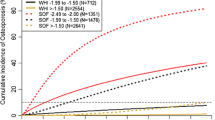Abstract
We have performed computer modelling of the relationship between bone mass, age and hip fracture in a conditional probability model using a notional population of 100 000 postmenopausal women aged 50 who have their bone density measured once. The computer model very closely reproduced the actual number of fractures in a Western Australian population. Intervention to bone loss completely in subjects with the lowest bone density (below 1 SD below the mean) would prevent 0.42 of a hip fracture per patient treated if the whole population were treated. Halving the rate of bone loss in the whole population would reduce hip fracture by two-thirds. These data suggest that hormone replacement therapy, which is the most effective therapy for preventing bone loss but which has the most side effects, should be focused on subjects with bone mass below 1 SD below the mean. The remainder of the population could be targeted with a public health campaign based on the lifestyle factors of increased dietary calcium and exercise which have been shown to slow but not stop bone loss.
Similar content being viewed by others
References
Gulland L, Prince RL, Knuiman M. The epidemiology of osteoporotic fracture in Australia. Bone Miner 1990;10:S271.
Gardsell P, Johnell O, Nilssen BE. The predictive value of bone loss for fragility fractures in women: a longitudinal study over 15 years. Calcif Tissue Int 1991;49:90–4.
Hockey RL, Hobbs MST, Goldswain PRT. Femoral neck fractures in Western Australia 1971–1988. University of Western Australia publication, 1990.
Melton LJ III, Kan SH, Wanner HW, Riggs BL. Lifetime fracture risk: an approach to hip fracture risk assessment based on bone mineral density and age. J Clin Epidemiol 1988;41:985–94.
Beck JR, Pauker SG. The Markov model of medical prognosis. Med Decis Making 1983;3:419–58.
Weiss NS, Ure CL, Ballard JH, Williams AR, Daling JR. Decreased risk of fractures of the hip and lower forearm with postmenopausal use of estrogens. N Engl J Med 1980;303:1195–8.
Hui SL, Slemenda CW, Johnston CC Jr. The contribution of bone loss to postmenopausal osteoporosis. Osteoporosis Int 1990;1:30–4.
Tosteson ANA, Rosenthal DI, Melton JM III, Weinstein MC. Cost effectiveness of screening perimenopausal white women for osteoporosis: bone densitometry and hormone replacement therapy. Ann Intern Med 1990,113:594–603.
Prince RL, Smith M, Dick IM, Price RI, Garcia Webb P, Henderson NK, Harris MM. Prevention of postmenopausal osteoporosis: a comparative study of exercise, calcium supplementation and hormone-replacement therapy. N Engl J Med 1991;325:1189–5.
Author information
Authors and Affiliations
Rights and permissions
About this article
Cite this article
Prince, R.L., Geelhoed, E., Harris, T. et al. Screening for osteoporosis by bone densitometry: A stratified intervention approach. Osteoporosis Int 3 (Suppl 1), 75–77 (1993). https://doi.org/10.1007/BF01621871
Issue Date:
DOI: https://doi.org/10.1007/BF01621871




